As one of Europe's most fascinating countries, Hungary offers a wealth of sightseeing attractions. Visitors to beautiful Budapest will marvel at its architecture, enjoy its opera, and take in its musical events. There's also the romance of the Danube River and Budapest's famed spa baths.Budapest has many celebrated tourist attractions and is a useful transport hub for exploring the rest of the country. Visit Hévíz and soak in the world's second largest thermal lake, Gyógytó. Visit Momento Park, one of the world's most bizarre attractions, where hundreds of giant statues were banished at the end of the communist era.Take a trip to Szentendre for a spot of shopping and visit the old university town of Keszthely to enjoy the quaint streets lined with trees, trendy cafés, and busy markets. The best season to visit Hungary is in the summer, between April and September, when the days are long and the weather warm.Most towns and cities in Hungary have reliable and affordable public transport but the best way to see the country is to hire a car and experience it all for yourself as it is not difficult to drive and navigate in the country.
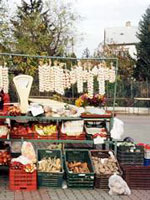
Balatonfüred has been the most fashionable resort on the Lake Balaton since the 18th century when the medicinal centre was established, and people are still drawn here on holiday because of its healing thermal waters. While the mineral baths are reserved for patients, the Balatonfüred resort area remains popular with tourists as there are three good beaches for swimming. The shores of the lake are great for all manner of water activities, from sunbathing to yachting, and there are also a number of cycle tracks along the lake and through the surrounding region. A wine tasting festival is held in August annually and the famous Anna Ball takes place on the weekend closest to the 26 July (Anna Day) at the Anna Grand Hotel.
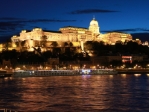
Buda Castle is the royal complex of past Hungarian monarchs. Sitting atop Castle Hill in the picturesque Castle District of Buda, the royal palace was first inhabited by King Béla in the 13th century. After an invasion, he fortified it against further attacks. Its strategic location straddling the Danube offered whoever controlled the city a defensive position and potential control of the main waterway. The castle has a mixture of architectural styles, ranging from Gothic to Baroque. Today it is the country's most important cultural centre, housing numerous museums with the majority of the buildings being historical monuments. The Budapest History Museum contains an exhibition explaining the history of the city, as well as archaeological remains of the palace. Also within the palace complex are the Hungarian National Gallery, the National Library, and the Ludwig Museum.
Address : 1 Szent, György tér
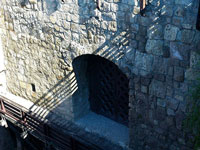
Sitting on the site of numerous historical events, Eger Castle overlooks its town namesake and is one of the most popular and famous attractions in Hungary. The original buildings included a cathedral and the Bishop's Palace, itself dating back from the 13th century. The castle was later fortified and the walls provided the cover for its determined defence by a small and outnumbered army against a Turkish force. The women who fought alongside the soldiers claimed their place in national consciousness during this much-celebrated historical event. The Dobó István Fortress Museum in the restored palace is one of the most popular museums in Hungary and has exhibitions on the history of the town and castle. Also within the castle grounds is the Heroes' Hall, which holds the grave of the celebrated leader, Dobó István, as well as the Prison Museum, Waxworks, and the underground rock-hewn artillery enclosures.
Website : gotohungary.com/about-hungary/-/netaview/1484173/castle-of-eger
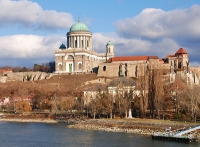
Esztergom combines captivating history with riverside charm. One of Hungary's most historically important towns, it was the capital for over 250 years and the birthplace of their beloved first king and saint, Stephen, who was crowned here in the 11th century. Today, it remains the religious centre of the country, with Hungary's largest church dominating the hill above the town next to the ruins of the medieval royal palace. The colossal basilica was the first cathedral in the country and the instrument for the introduction of Roman Catholicism. It offers wonderful views from its enormous dome and contains a crypt and priceless treasury collection. Below is the pretty Watertown District, with its uneven cobbled streets winding up the hill towards the castle. Esztergom is conveniently close to Budapest and makes a great excursion from the city.
Website : www.esztergom.hu
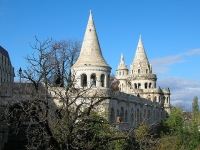
Built in 1905 on the medieval castle walls, the neo-Romanesque ramparts were so named after the city's fishermen whose duty it was to defend this side of the hill during the Middle Ages. But the existing bastion never actually served a defensive purpose. The fairytale-like ramparts are purely ornamental, with gleaming white cloisters and stairways connecting seven turrets symbolic of the Magyar tribes that conquered the Carpathian Basin in the 9th century. Set back from the ramparts is an equestrian statue of King Stephen, a memorial to the founder of the Hungarian nation. The view from Fisherman's Bastion is outstanding, looking over the Danube, the Chain Bridge, and the Parliament Buildings with Pest stretching out into the distance. Floodlit at night, the bastion itself is also a mesmerising sight from across the river. In fact, seeing as entry is free it is definitely worth visiting the Fisherman's Bastion twice, once at night and once during the day.
Address : District I, Szentháromság tér
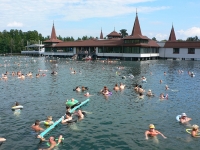
Hévíz is the site of world's largest thermal lake: Gyógytó. It is the most extraordinary sight with its huge milky blue surface covered in water lilies and steam. The warm water wells up from a volcanic crater spring about 40 metres (128ft) below the surface and provides year round swimming, although the recommended maximum time in the water during any one session is one hour. The mud on the bottom and edges is said to be slightly radioactive which is good for various medical conditions but only in small doses. A pavilion in the centre of the lake is reached by a covered bridge and indoor swimming takes place in an area enclosed with Plexiglas. Gaps in the plastic lead to the rest of the lake where swimmers can float among the water lilies and swim between the platforms bobbing on the surface. There are also various other spa and health treatments that can be enjoyed.
Address : Lake Balaton region
Website : www.heviz.hu/en
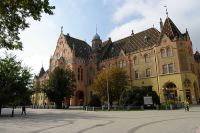
A 53-mile (86km) drive from Budapest, Kecskemét makes for a wonderful short trip from the city. While this garden city is quite large, with more than 100,000 residents, the place has a uniquely small-town charm. Walking around the scenic city centre is pleasant, with the abundance of open squares and avenues peppered with colourful Art Nouveau buildings. There are a number of attractions in Kecskemét that visitors will enjoy, including the distillery tours at the Pálinka Museum, the Hungarian Photography Museum, the Museum of Hungarian Folk Art and Handicrafts, and the beautiful architecture and art collections at the City Hall. The city has existed in some form since at least the 1300s so it is no surprise that it holds many old and hidden gems for visitors.
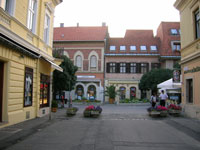
Keszthely is a university town with trendy cafes, tree-lined streets, and busy market areas. Modern history shows Kesthely dating back some 760 years, inhabited since the Roman Empire. Its most import sight is the Festetics Palace, with the Helikon Palace Museum and Library both in one of its baroque wings. Varosi Strand is great for travelling families, with its beach and amusement area. It has water slides, a big pool, and various play spaces, as well as nice lawns, a beach, and loungers. Keszthely likes to describe itself as the capital of Lake Balaton and it is the best town from which to explore the surrounding lakeside area, including the nearby Kis-Balaton nature reserve (excellent for bird watching) and the thermal lake at Hévíz.
Address : Western shore of Lake Balaton
Website : www.keszthely.hu/en/
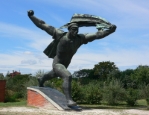
A popular yet bizarre attractions, Memento Park contains the giant figures of the communist era that once filled the streets of Budapest. Among them are the forms of Lenin, Marx, and Engels, as well as memorials to Soviet soldiers and communist martyrs. There are also exhibitions detailing the history of the Soviet occupation in Budapest, contributing to a unique collection of artefacts and a fine location to educate oneself on the nature of communism.
Address : District XXII, corner of Balatoni ut and Szabadkai utca
Website : www.szoborpark.hu
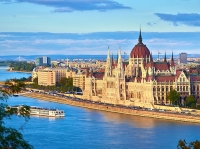
On the bank of the Danube stands one of the world's most beautiful buildings of parliament, an imposing sight and a prominent feature of the city's panorama. With its red dome, white stone lace ornamentation, and spires, it is the city's most decorative structure. Stone lions flank the entrance guarding a rich interior of marble and gold, statues, and columns. Magnificent artefacts are seen on guided tours, including the 1,000-year-old crown of the first Hungarian King. The grand edifice, stretching for 250 metres (820ft) along the embankment, is one of the biggest national assemblies in the world. The tours take between 45 minutes and an hour.
Address : District V, Kossuth Lajos tér 1-3
Website : www.parlament.hu
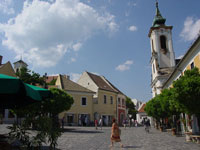
Known as 'The Pearl of the Danube Bend'. Szentendre is a quaint old market town situated on the slopes of the Pilis Mountains. Meandering cobbled lanes, little squares, red-tiled roofs, brightly painted houses, and Orthodox churches give it a charming and artistically picturesque setting. Serbian refugees inhabited the town in medieval times and their style contributed to the charisma of the town's haphazard structure and Balkan flavour. Numerous Serbian churches add to the collection of historical buildings. In the 1900s, the town became a favourite retreat for painters and sculptors, resulting in a wealth of museums and art collections scattered among the tourist souvenir and handicraft shops. Being close to Budapest, the town is a popular excursion from the capital and has become one of the hotspots for tourism in the country. Be warned though, summer weekends can get rather overcrowded.
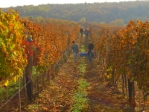
With its rolling vineyards and century-old cellars and taverns, Szépasszony Valley is a favourite attraction in Eger. Wine producers welcome visitors into their quaint old cellars, hollowed out of the porous rock hundreds of years ago. Here, some of the country's finest red wines can be tasted, including the unique Bull's Blood. The rows of cellars are numbered and each has a particular charm, whether it's the chequered tablecloths of an underground tavern or the wooden barrels of fermenting grapes in the uneven rock passageway. It is possible to visit, by prior arrangement, the 'Istenes Pince' or Godly Cellar, the oldest historic cellar in the region. It operated as a secret church during the Turkish occupation, and the stone altar and religious works of art still remain in this very special place. Where the name 'Valley of the Pretty Women' comes from is unclear, but it is a charming name for a charming area.
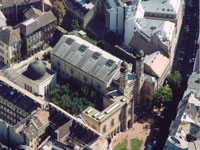
Situated within the charming old Jewish quarter of Pest, the Great Synogogue is one of the largest in the world. Its style is Byzantine-Moorish, with patterned brickwork in the red, blue, and yellow colours of the city's coat of arms. Gilded domed towers, archways, and beautiful windows make this one of Budapest's great landmarks. The splendid interior glitters with lights and gilded arches while balconies line the walls. The ceiling is covered in Stars of David and the floor is tiled in decorative stars. On Jewish festivals, it's packed with Jews from all over Hungary who come to celebrate within its splendour. Next door is the Jewish Museum, containing a Holocaust Memorial Room and relics from the Hungarian Jewish Community. In the courtyard is the Holocaust Memorial in the shape of a weeping willow tree, each metal leaf engraved with the names of those who have passed away.
Address : Dohany utca 2-8 in VII district.
Website : www.greatsynagogue.hu
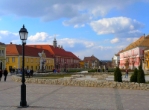
Vác is a pretty Baroque town on the east bank of the Danube Bend. Vác is an accessible and popular tourist destination in Hungary, especially as a day trip from Budapest. But despite its many attractions and charms, it's wonderfully less crowded than some of the other famous towns on the Danube Bend. The stunning cathedral, founded by the first Hungarian King, St Stephen, is the most popular attraction in Vác, though there are many other sites to visit. A more macabre attraction is the Memento Mori Crypt, which houses a number of naturally mummified corpses and the incredibly well-preserved clothes and decorated coffins belonging to them. The Memento Mori Crypt is a very famous archaeological discovery which has enabled several breakthroughs in science and ethnography and is listed as a World Heritage Site. Vác also has a wonderful pedestrianised town square, surrounded by colourful buildings and a splendid promenade along the Danube River.
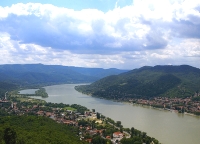
Situated on the abrupt loop of the Danube beneath steep hills, Visegrad was once a Roman stronghold on the border of the Roman Empire and the second home after Buda to Hungary's royalty in the 14th and 15th centuries. On the banks of the river are the ruins of the magnificent palace, one of the finest ever built in Hungary. It is now the open air King Matthias Museum. Today the small, sparsely populated town has a pleasantly lethargic atmosphere that belies its past glory and importance and it makes a peaceful excursion from the crowds of the big city. As all of this intriguing history suggests though, the village is a delight for history buffs and retains an old-world feel. The village is also a good base for outdoor activities in the lovely surrounding countryside and there is an excursion centre behind Castle Hill which can organise things like hiking, canopy trails, and cycling in the region.

Travel Guide powered by Word Travels, copyright © 2023 Globe Media Ltd. By its very nature information in this travel guide is subject to change at short notice and travellers are urged to verify information on which they're relying with the relevant authorities. Neither Globe Media Ltd nor Travel Vogue can accept any responsibility for any loss or inconvenience to any person as a result of information contained above.